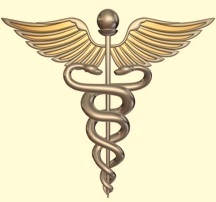A Guide for Physicians
and Other Healthcare Providers
Bedside Manner

Everyone talks about bedside manner – usually when referring to doctors.
Why is this so important?
When a patient sees a physician in the office or hospital for the first time, s/he has no idea what kind of doctor this is going to be. The person may have talked to friends or family members who may have some prior experience with him or her. The pre-visit research may have even included whatever data could be found on the Internet about the individual. However, the patient doesn’t really know or have a feeling about what the visit will be like till it happens.
So, from a personal point-of-view, the only initial way the patient has of evaluating a new physician is by his/her bedside manner. This assessment, by the way, happens fairly quickly in the encounter – probably within the first 60 seconds - some say even less. One of my patients has a 15 second rule: If she doesn't like the doctor within the first 15 seconds of the visit, if she doesn't get the sense that this is a caring individual within that time, she has basically already made up her mind that this will be a waste of time and probably won't do anything that is recommended.
Is there a knock on the door, a smile, a sense of courtesy, a handshake, or eye contact? Is there recognition that someone else is in the room besides a computer? Is the patient permitted to explain his symptoms? Does it seem like anyone is listening?
We’ve all heard the stories about busy doctors who don’t seem to have time for any of this superfluous stuff. They just barge into the room, go to the chart or computer terminal and start asking questions without waiting for the full answers, write a prescription and go for the door while the patient is trying to tell them about a problem that is really concerning them. The doctor says, “We’ll talk about it next time"; but when the patient goes to check out, the receptionist says, “The doctor will see you back in six months.”
That’s just one example, of course, of poor bedside manner. There are many horror stories much worse than this about how badly patients were unjustifiably treated by doctors, nurses and other medical “professionals”.

|
Bedside manner is all about the physician’s total approach to patient care. It encompasses all the attributes of medical professionalism blended in with the specific personality of the individual and with the ability to comfortably communicate a certain degree of concern about the patient’s welfare.
Patients want to feel comfortable with the people with whom they are entrusting their lives. They want to feel like someone is on their side when they are ill. They need to feel that the person who is advising them to do scary things like surgery is really concerned about them and has their best interests at heart.
If you have good bedside manner, people will tell you and compliment you on it. If you don’t have good bedside manner, you won’t hear about it, and you will go on practicing like you usually do and wondering why you don’t have as many patients as the doctor next door.
If people aren’t telling you that you have good bedside manner, you really need to read this next section!
Specific qualities of good bedside manner
--Prepare for the Visit - Spend a few minutes reviewing the patient's history and medical problems before you even enter the room. Remind yourself about what happened on the last visit, what tests you ordered, what the results of those tests are, what prescriptions you wrote, etc. Patients are impressed if you know what's going on with them ahead of time without having to look up or ask for a lot of information about them while you're in the room with them. By the same token, they are also annoyed if you don't know their history or test results that they have been waiting 2 weeks to hear about. Also, try to anticipate their questions and how you are going to answer them before the visit, especially if the discussion is going to be about something serious or life changing. At least have an idea about what your plan of care might be ahead of time.
--Simple Courtesy – Knock before you enter. Excuse yourself if you have to take a phone call. Always be polite. Always use the person’s last name prefaced by Mr., Mrs., Dr., or Rev., or whatever his or her official title is. Pay attention to this. Don’t call a Doctor or Reverend a “Mister”. The only exceptions to this rule are a) if your patient is a child or at least less than 18, or b) if your patient specifically requested or insisted you call him/her by their first name or nickname.
--Make eye contact – Let the patient know that you are there for the sole purpose of seeing him/her. With computers in every room, there is a tendency just to go in the room, right to the terminal, and barely glance at the person whose life you have in your hands. Patients notice this.
--Shake hands – firmly, with conviction, but not too strongly in case they have arthritis. Never hug and never touch in any other way except as part of the exam. A pat on the upper back is okay as the patient is leaving, but never more than that.
--Greeting – Say a word or two to the patient with a smile as a way of recognizing his/her humanity. “Nice to see you.” Or, “How are you?”
--Sit down – This is very important for 2 reasons: a) If you’re sitting, it is perceived that you are in the room longer that you really are. b) You want to be on the same eye level as your patient whenever possible. Try never to “talk down” to the patient if you can avoid it. It may be perceived as condescending.
--Listen – Hear the patient out as much as you have time for. This is what patients complain about most – that their doctors never listen to them. The patient needs to feel that you understand what is going on with them. If you’re not looking at the person when s/he is talking to you, you will be perceived as not listening, even if you have heard and digested every single word.
--Respect your patient's opinions, acknowledge his/her beliefs even if you don't agree. NEVER be condescending. Remain open-minded. Never be so entrenched in your own opinions that you can't allow your self to see the other side. If you need to express disagreement, always do so respectfully, letting the person know you understand how or why they might have that opinion, but explain that you feel differently because.... Always try to explain why you disagree. It may be based on the medical literature, research or your experience, but it should be something credible. To answer, ..."Because I'm your doctor, and I said so, that's why!" doesn't cut it anymore. Doctors could get away with that in the 1940's and 50's, but not now.
--Examine – The patient needs to feel that you’re at least concerned enough about his/her symptoms, that you will examine the area of complaint, even if you know you’re not going to find anything. (Actually, this is very important to do anyway, because sometimes you actually do find something that you would have missed otherwise.)
--Communicate – Explain your findings and your diagnosis in everyday lay terms as much as possible. Become a teacher. Explain why a certain test is needed or why you’re prescribing a specific treatment. Also explain the main side effects of whatever test or treatment you are ordering. If the patient’s memory is not good, write it down for them or call the closest family member to explain things. Little or no explanation from doctors is another big complaint from patients and families, so we all need to pay more attention to this one.
--Express appropriate concern about your patient’s situation. This is the mainstay of good bedside manner. Perhaps s/he just needs reassurance about a relatively benign problem, but never, ever slough it off as unimportant, even if you know that it isn’t. It’s always important to the patient. Otherwise, s/he wouldn’t have brought it up. If it’s a serious problem, definitely be concerned, but never leave a patient with no hope or no other options. Don't ever say that there is nothing else that can be done, even if you are thinking that. There is always something that you can do. Even if the person has an incurable, untreatable, terminal disease, you can still offer support with symptomatic therapy, hospice care, and assurances that you will do everything you can to prevent severe pain or suffering, or you can refer the person to someone who has experience in this area if you don't feel comfortable with it. This is not nothing. It is something to a patient at the end of the line and it offers some hope for at least control of suffering.
This page on "Bedside Manner" was last updated on October 19, 2019.

Disclaimer | Privacy Policy | Copyright | Sitemap | Contact | Comments













